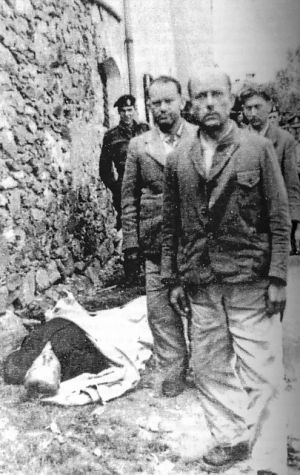Georg Michalsen

Georg Michalsen next to the body of Globocnik with Hofle in foreground
Georg Michalsen was born on 13 September 1906 in Wendrien, under the name of Michalczyk, which he changed to Michalsen in 1941. He was a member of the Höfle ‘Einsatz Reinhardt’ murder squad. He played a leading role in the mass deportations from the Warsaw and Bialystok ghettos. Michalsen was with Odilo Globocnik, the former head of Aktion Reinhardt and his deputy, in the mass murder programme,Hermann Höfle when Globocnik was captured by the British Army and committed suicide. He was photographed by the British standing with Höfle next to the body of Globocnik in Paternion, Austria, in May 1945.
Michalsen was interrogated by the British Mob Unit CSDIC between 2-
“I can make the following statements regarding the prior history of the Stroop mission and the intention to transfer the enterprises to the camps in the district of Lublin: with the ending of the actions of the summer of 1942, my relations to Warsaw had been discontinued. I was most delighted that this matter came to an end for me, and after my return to Lublin, I contacted SS-
Michalsen recalled his time in Warsaw during the ghetto revolt:
“On the following day, which was the second day of the Aktion, Stroop commanded that I should refrain from any involvement because it was only a disturbance because of the “stupid firms. On the following day the wire came from Krakow and I was ordered back to Lublin. Stroop initiated this recall. As early as on the second day of the action I telephoned Globocnik and told him that I practically was de-
When H. maintains that I led this action while wearing a steel helmet, with a whip and machine pistol, this is not true. I had left my steel helmet in Lublin and had arrived in Warsaw with my hat. I did not get myself a steel helmet there. At the same time, I only had a pistol, not a machine pistol. More so I did not have any justification for carrying a whip. I do no longer know if the transfer of the Jews went around the Ghetto to a transfer camp. I also cannot state if I accompanied the transport to the transfer place. I don’t think I went along to it. I did not take part in further transports from Warsaw. Of special note is the fact that I was not a participant in the transport of Jews of the Schultz firm to Trawniki. If such a transport took place, then possibly SS Oberscharführer Bartetzko was involved.” Were you ever at the transfer area during the first three days of the Stroop Aktion?
“During those days everything was so chaotic and I was at so many places in the Ghetto that I don’t remember where. As a torture Stroop sent me here and there, especially to the factories with the order to make sure that the Jews of the firm had to line up for roll-
When I am being told that Mohwinkel was in Warsaw during the Stroop Action, I now seem to remember that Mohwinkel had something to do with the transport and selection of Jews for Lublin, especially for the Deutsche Ausrustungswerke (DAW). Basically it was Globocnik’s endeavour to only take real labour forces into these camps, which then could become pure and exclusive labour camps. Women, children and sick people were not to be taken into these camps, as long as they were not labourers themselves. In Globocnik’s plans these should not be transferred but remain in Warsaw for the time being so that they would be captured in the last final cleansing of the Warsaw Ghetto and transported off to Treblinka. When I was asked what was to happen to the people who were transported off to Treblinka. I can only say that Globocnik did not tell me explicitly that they were sent to Treblinka for liquidation, he did not say that, but it was just inferred in the general circumstances. This plan as Globocnik envisioned it did not get realised, the firms insisted that all people who were in their factories would be taken to the camps. The firms assumed that no selections would take place, but all Jews of their factories would be transferred without exception. At the end, Globocnik had to agree to this attitude by the firms. As a fact, such selections among the members of the firms’ labour force were no longer made before they were transferred, Globocnik still did not like it, and I remember that at a later time he mockingly remarked that in both camps there were too many women. Globocnik also made fun about the kindergarten in Poniatowa – this happened during an inspection of the Camp Poniatowa – at this inspection by Globocnik, Lerch was also present.”
Georg Michalsen died on May 21, 1993.
SOURCES:
French L. Maclean, The Ghetto Men: The Destruction of the Jewish Warsaw Ghetto April – May 1943, Schiffer Publishing Ltd 2001
J. Poprzeczny, Hitler’s Man in the East – Odilo Globocnik, McFarland, Jefferson 2004
National Archives Kew WO 204/ 13006
Georg Michalsen Personnel File – Yad Vashem, Israel
Photograph – Chris Webb Private Archive
© Holocaust Historical Society October 5, 2021

